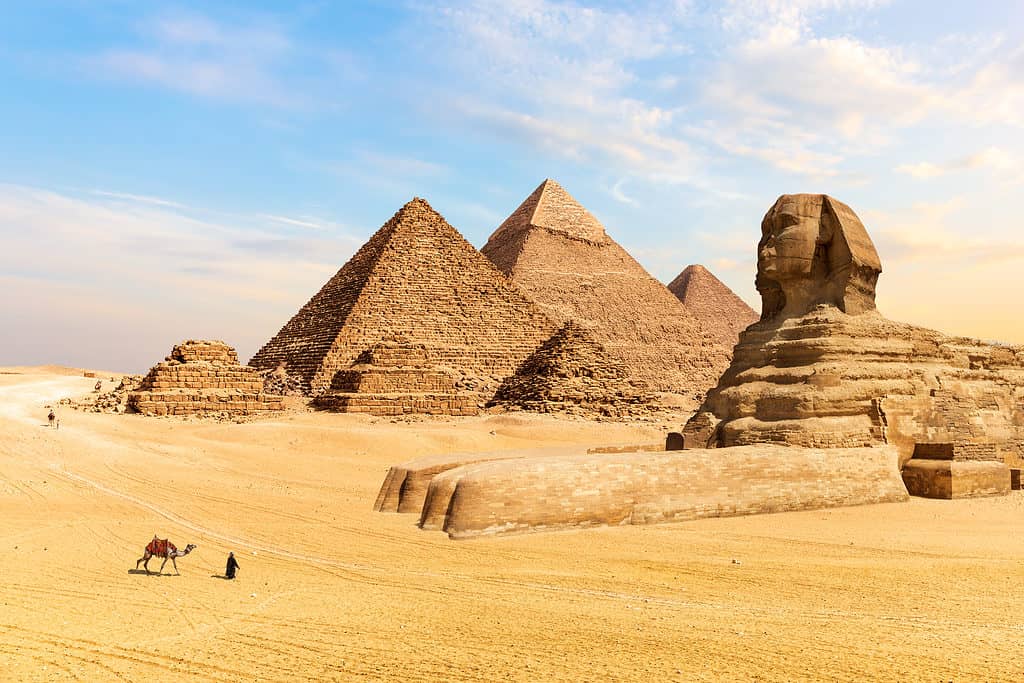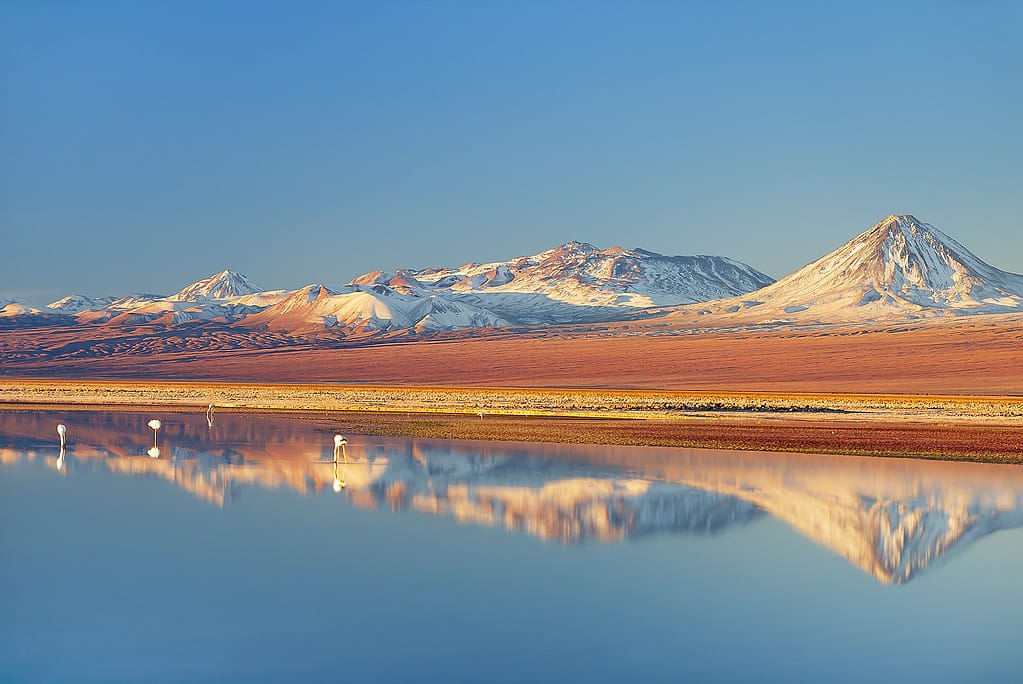The world is a place of extremes. In people, culture, animals, and even weather! In fact, weather has a lot to do with everything else in a place, people, culture, and animals alike. Dry weather means specialized animals, specific cultures, and people who have learned to live differently. Today, we are going to be looking at one aspect of weather, specifically, the driest country on earth. Let’s get started!
What is the Driest Country on Earth?

Egypt is the driest country in the world, according to annual rainfall levels.
©AlexAnton/Shutterstock.com
The driest country on Earth is Egypt, with an average annual precipitation of only 18 mm, or less than an inch.
Egypt sits in the northeastern corner of Africa and borders the Mediterranean Sea to the north and the Red Sea to the east (neither of which has drinkable water). The Sahara Desert, one of the world’s largest and hottest deserts, covers much of Egypt. With a desert covering most of your country, it makes sense that there isn’t a lot of rain happening.
The (famously) desert climate of Egypt is known for its extremely low humidity, high temperatures, and almost total lack of rainfall. Egypt’s only main source of water is the Nile River which flows through the country from south to north. Without the Nile, life in Egypt would look extremely different, and the history of the region wouldn’t look anything like it does today. The Nile Valley and Delta are home to most of Egypt’s population and agricultural land and have been for thousands of years.
Some of the other countries that have very low precipitation levels are Libya (56 mm), Saudi Arabia (59 mm), Qatar (74 mm), the United Arab Emirates (78 mm), and Bahrain (83 mm). All of these countries are located in the Middle East, an area that has historically had lower levels of rainfall than other regions.
To survive, many of these countries use things like desalination plants and groundwater extraction. They may even import water for their population.
The Country With the Driest Place on Earth

Chile’s Atacama Desert is known as the driest place on earth.
©longtaildog/iStock via Getty Images
While Egypt is the country with the lowest annual rainfall on earth, it isn’t necessarily the driest place on earth. That award goes to a location in Chile, a country in South America with one of the most unique climates globally.
Chile stretches along the Pacific coast for more than 4,000 kilometers (2,500 miles), and within those borders is one of the most interesting places in the world: the Atacama Desert. The Atacama Desert is officially the driest place on Earth, and it’s really, really dry. This region receives less than 1 millimeter (0.04 inch) of rain per year, and some areas have not seen any precipitation for more than 500 years.
The cold Humboldt Current, which prevents moist air from rising and forming clouds, and the Andes Mountains, which block moist air coming from the east, cause desert conditions.
What Lives In the Driest Places on Earth?
Despite water being essential for life on earth, some of the most interesting plants and animals live and thrive in these water-lacking wastelands and have for millions of years. Let’s take a look at some of the most unique creatures adapted to live in these dry places.
Egypt
The driest places on Earth are home to some amazing forms of life that have adapted to the harsh conditions. In Egypt, the country with the lowest annual rainfall, there are several animals that can survive in the desert environment.
Is there any desert animal more famous than the camel? Camels adapt extremely well to life in the desert. They store fat in their hump and have the ability to go for long periods without drinking water. For comfort and visibility, they also have thick eyelashes and nostrils that can close to protect them from sandstorms, sort of like goggles and nose plugs for humans.
Another animal in Egypt is the Dorcas gazelle. Dorcas gazelles have the remarkable ability to lower their body temperature (and subsequently water loss) by breathing slowly and panting. They also have light-colored fur that reflects the sun to reduce internal temperature and hooves adapted for walking on the sand.
The sand cat is a species of cat that lives in sandy places (hence the name), usually long distances from water. Sand cats have much larger ears than domesticated cats for hearing the subtlest rustles from prey, and in places where it gets cold at night, they have developed thick fur. During the day, they usually rest in underground burrows to help manage the heat.
Chile (Atacama Desert)
Although Egypt has a lot of desert-dwelling creatures, the Atacama Desert in Chile is a bit more extreme in some places, and as a result, the animals and plants that live there are equally extreme. In fact, some of the creatures exclusively live
One of the coolest plants around, the llareta/yareta, is a cushion-like plant that grows very slowly and can live for thousands of years. Llaretas have extremely dense branches that trap heat and prevent water loss but also give them their bubble-like shape. They also produce a special resin that protects them from insects and fungi.
The vicuña is an animal that is a close relative of the rather famous llama. Vicuñas have a very fine wool that is often harvested for clothing. Often, vicuñas aren’t able to live in the Atacama proper unless the snowmelt allows grass to grow, so they sort of count on this list!
The only real animals that are able to live in the desert full-time are quite small. One of the common examples is the leaf-eared mouse. Birds, however, are much more common in the region. The Andean flamingo, for example, feeds on algae and brine shrimp in the salt lakes found across the area. Technically, seals and sea lions also live in the desert, but exclusively along the coast of the Pacific Ocean, where the desert butts up directly to the sea.
Countries With Low Access to Water

Although water surrounds the Bahamas, the nation lacks easy access to clean drinking water and has among the lowest per capita water availability in the world.
©iStock.com/Rob Atherton
While Egypt is the driest country according to rainfall and the Atacama Desert is the driest singular place in the world, there’s another way to answer the question: countries with low access to water as a renewable resource. For example, Egypt is number 85 on this list, meaning countries like Switzerland, Ireland, and Denmark all technically have less total renewable water than Egypt does.
These countries have very low levels of renewable water resources, which means that they depend on rainfall, groundwater, and surface inflows from other countries to meet their water needs.
- The Bahamas: 26 cubic meters of water per person per year. The Bahamas is a set of islands in the Caribbean Sea, meaning most of its freshwater comes from rain and underground aquifers. Due to its location, however, the aquifers are vulnerable to saltwater intrusion and pollution.
- Kuwait: 28 cubic meters of water per person per year. Kuwait is a country in the Arabian Peninsula, where the desert covers most of the land. Kuwait relies heavily on desalination plants, which produce freshwater from seawater, but these types of plants are extremely costly to run and require a lot of energy.
- Saint Kitts and Nevis: 38 cubic meters of water per person per year. Saint Kitts and Nevis is another island nation in the Caribbean Sea. Floods, hurricanes, and being surrounded by seawater make it extremely tough to find clean sources of water on the island.
The photo featured at the top of this post is © Oleg_P/Shutterstock.com
Thank you for reading! Have some feedback for us? Contact the AZ Animals editorial team.






